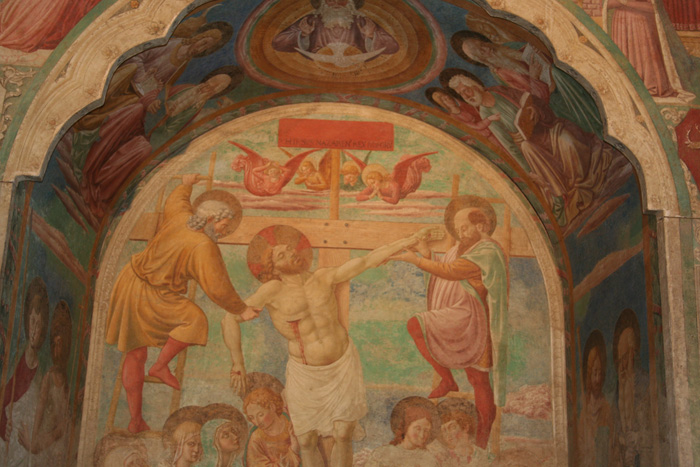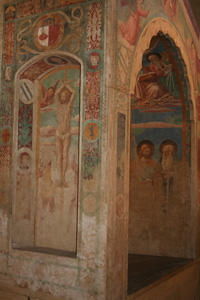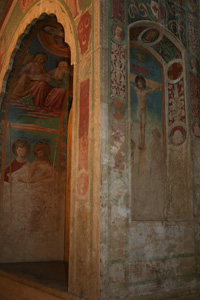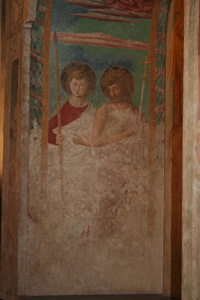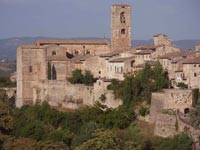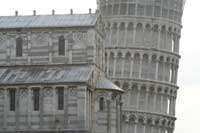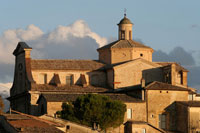| |
|
Benozzo Gozzoli's (1420-1497) main works are three extensive cycles of frescoes. The cycle decorating the main apsidal chapel of the Church of San Francesco in Montefalco depicts episodes and deeds from the life of St Francis. The cyle depicting the Procession of the Magi with decorative charm coupled with Flemish realism was executed on the walls of the private chapel of the Medicis' residence in Florence. The cycle of St Augustine is in the apsidal chapel of the church of Sant'Agostino in San Gimignano.
And in 1467 he painted the Tabernacle of the Executed, and the Shrine of the Visitation, the detached frescoes are now on display in the Palazzo Pretorio, Certaldo, and in the Biblioteca Comunale, Castelfiorentino, respectively.
Palazzo Pretorio, the most representative monument in Certaldo, was the ancient residence of the Alberti Counts, which they built in the late-12th century atop the ruins of the family's former homes.
The building has arched windows a facade decorated with merlons and a tower, and a court adorned with coats of arms in stone and glazed terracotta, representing the families of each of the vicars that lived in and governed from there.
Today, the prisons are still visible as are the meeting rooms, the archive, the chapel and the private lodgings of the vicars. On its facade and inside its courtyard are numerous coats of arms, representing the families of each of the vicars that lived in and governed from there.
The interior is decorated with frescoes dating from the I3th to the 16th century. Do not miss the Knights Room with paintings by Francesco Fiorentino (1445-1497), the “Madonna and Child” and “Dead Christ”, and the Audience Hall with paintings of Francesco Fiorentino too, the “Pietà” and “Doubting Thomas”. Next to Palazzo Pertorio is the San Tommaso and Prospero church (Church of St. Thomas and Prosper), which dates back to the 13th century, where one can admire 15 th and 16 th century frescoes and sinopias; the Church houses the most important work, The Tabernacle of the Executed (c. 1464/65), a fresco by Benozzo Gozzoli. Originally, this work was located in the plain, near the Agliena stream: those sentenced to death, before their execution, were brought near this frescoed chapel (The Tabernacle of the Executed), where they received the last solace. The chapel is still visible under the bridge, on the right side coming from Poggibonsi.
|
'From 1464 to 1465, Benozzo resided in Certaldo, a small town in the heart of the Elsa Valley, which in 1415 had become one of the three Vicariates into which the Florentine Republic was administratively divided, and whose jurisdiction extended from Valdelsa to Val di Pesa and stretches of Valdarno. Vicariate records indicate that, at that time, Certaldo was where all criminal trials were held and sentences passed on those who lived within the confines of the Vicariate. For this reason, the Vicar of Certaldo commissioned a majestic tabernacle from Benozzo which, at that time, was situated near the bridge over the river Agliena, outside the city walls, where capital punishment was traditionally carried out by beheading. The condemned were accompanied to this chapel to be comforted by the brothers of the Company of Justice, a lay institution that assisted them in their final hours, encouraging them to pray and repent. Because of this tradition, the tabernacle was known as that 'of the Executed', and it was in this context that the iconographic theme of the frescoes was chosen, namely the passion of Christ and the martyrdom of certain saints, stories taken from the Holy Scriptures that were intended to help the condemned to better endure the grim end that awaited them. The Deposition which occupied the main wall thus symbolised the culminating moment in the salvation and possible redemption for those who confessed their sins. Depicted on the external archway is the Annunciation of the Virgin, while the inner wall bears a representation of the Deposition, with Joseph of Arimathea and Nicodemus, standing on two ladders to take down the now dead Jesus from the cross. The face of Jesus shows no sign of the pain he had suffered, a detail that might offer comfort to those sentenced to death, and only the bleeding wound on his ribs symbolises his Passion. Featuring in the scene are several apostles and the Madonna accompanied by Mary Magdalene. The underside of the arch on the main facade is decorated with God the Father surrounded by the Evangelists Matthew and Mark on the right and Luke and John on the left. The walls of the extrados are decorated with the figures of Saints Longinus, John the Baptist, Jacob and Anthony. The exterior walls are painted with the Crucifixion and the Martyrdom of Saint Sebastian. The rear facade, on the other hand, was dedicated to the theme of the Resurrection, the first scene that appeared to the condemned as they were led from the Court Room at the Vicarial Palace to the 'Meadow of Justice', a small grassy area on the riverbank.
Critics are now unanimous in attributing to Benozzo the compositional structure, pictorial designs, the direction of works and the execution of certain parts, while an important role has been attributed to his studio and, in particular, to Giusto di Andrea who notes in his Diary that this was the last work he carried out at his master's side before moving to Florence where, in March 1465, he rented an artist's studio of his own. This evidence has made it possible to date the work to the first few months of that year. This hypothesis is supported by a letter sent by Benozzo to Lorenzo de' Medici on 4th July 1467, thanking him for interceding on behalf of one of the artist's co-workers (Giovanni della Cecca di Mugello, who had been accused by the Augustinians of San Gimignano of stealing some bed sheets). Indeed, this letter makes explicit reference to the work in Certaldo as having been completed some time earlier. It also provides confirmation of the fruitful relationship and the strong bond between Benozzo and the Medici family.
Certain frescoed parts of this tabernacle, too, have been lost due to damage caused by humidity and, for this reason, the paintings were detached in 1957 and moved to the former Church of Saints Thomas and Prosper, annexed to the Vicarial Palace'.[1]
|
|
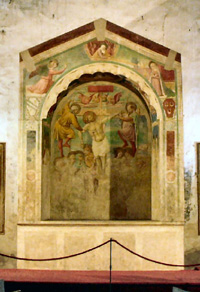 Tabernacolo dei Giustiziati, affreschi staccati Tabernacolo dei Giustiziati, affreschi staccati
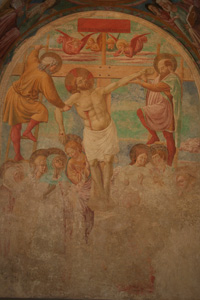
Deposizione dalla Croce, facciata principale
|
|
|
|
| |
|
Benozzo Gozzoli
|
|
|
Benozzo Gozzoli (b. ca. 1420, Firenze, d. 1497, Pistoia) was an early Italian Renaissance painter. He was the son of the tailor Lese di Sandro, his original name is Benozzo di Lese di Sandro. His father was from a citified branch of a family of farmers. The name Gozzoli, which though absent from the 1550 edition of Vasari's Lives, appeared in that of 1568 comes from the name "Ghozzolo" common in the other branch of the family, the one that had remained in the country.
Gozzoli's formative collaborations included those with Lorenzo and Vittorio Ghiberti on the third bronze door of the Baptistery, Florence (1444), with Fra Angelico on the pictorial decoration of the Dominican convent of San Marco in Florence (1444-45), with Fra Angelico on some frescoes in the chapel of Pope Nicholas V in the Vatican (1447), and again with Fra Angelico on the ceiling of the Chapel of San Brizio in the cathedral at Orvieto (1448).
In 1450 he was in Montefalco in Umbria where his first independent works were executed. He left frescoes in the churches of S. Fortunato and produced a panel painting of the Madonna della Cintola for the high altar (now in the Pinacoteca, Vatican). For the church of S. Francesco, the Franciscans commissioned from him the fresco cycle with Scenes from the Life of St Francis (1450-52). At Viterbo he painted nine frescoes of scenes from St Rose's life (after 1453), which were lost during the course of extension work in the church in 1632.
Between 1456 and 1459 Benozzo put in an irregular appearance in various places in Central Italy. He painted an altarpiece at Perugia for Collegio Gerolominiano (1456); at Sermoneta he painted a Madonna in Glory for the cathedral (1458). He was in Rome in 1458, working on the displays (flags and standards) for the coronation ceremony of Pius II. In Rome he also frescoed the Albertoni chapel in Santa Maria d'Aracoeli of which a St Anthony of Padua survives.
In 1459 Benozzo was summoned to Florence by the city's most illustrious patrons, the Medici, to carry out the prestigious commission - the most important of his career - of decorating the walls of the chapel in their palace. The subject chosen was the Journey of the Magi which he used to portray various members of the Medici family, with its young princes handsomely, even flamboyantly dressed and all set against a wonderful landscape, creating a fairy tale of the Renaissance (1459-60).
In 1461 he produced the altar painting of a Sacra Conversazione for the Compagnia delle Purificazione in Florence. The painting has since been taken apart and is kept in various museums. By 1463 he was working at San Gimignano on a cycle of 17 scenes from the life of St Augustine in the choir of Sant'Agostino (last scene signed and dated 1465) and on a fresco of St Sebastian (1464). In 1467 he painted the Tabernacle of the Executed, and the Shrine of the Visitation, the detached frescoes are now on display in the Palazzo Pretorio, Certaldo, and in the Biblioteca Comunale, Castelfiorentino, respectively. In 1471 he executed a panel painting of the Triumph of St Thomas Aquinas (now in the Louvre, Paris), in 1484 the Shrine of the Madonna delle Tosse, the detached frescoes of which can be seen also in Castelfiorentino.
Between 1469 and 1485 he painted his most extensive commission, a series of 25 frescoes of Old Testament scenes for the Campo Santo (cemetery), Pisa. In 1944 a bombing raid, followed by a fire, destroyed or damaged the greater part of the frescoes. Forced to leave Pisa, along with other Florentine residents of the city, following the invasion by Charles VIII and the expulsion of the Medici, Benozzo returned to Florence. He is in Florence in 1497 but sometime during the year he moved to Pistoia where his sons were already working. He had probably been summoned there by the city government to fresco a large Maestà in the City Hall. Benozzo died in Pistoia on October 4, 1497, probably of plague, and was buried in the cloister of the convent of San Domenico.
|
|
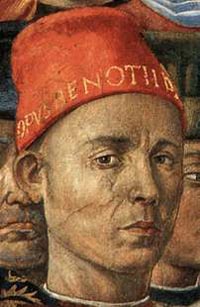
Autoritratto (Opus Benotii) nella
Cappella dei Magi |
 |
|
|
[1] La chiesa dei Santi Tommaso e Prospero
Si tratta della più antica chiesa di Certaldo alto. Suffraganea fin dal secolo XIII della pieve di San Lazzaro a Lucardo.
Le più antiche testimonianze su questa chiesa si trovano murate nell'edificio stesso e sono due iscrizioni recanti le date 1215 e 1366. Nel 1415, dopo che era stato costruito il palazzo Pretorio, ne divenne l'oratorio. Nello stesso XV secolo il patronato spettava alla famiglia Gianfigliazzi.
Nel 1575, in occasione di una visita apostolica la chiesa venne trovata in precarie condizioni statiche: Quoad fabrica Ecclesiae minatur ruinam versus altare maius, unde indiget festina reparatione. Nel 1589 risulta che nella chiesa vi fosse già stato collocato il sepolcro di Giovanni Boccaccio e nel 1654, all'interno della chiesa, erano collocate altre sepoltue.
Fin dal XVI secolo il terreno retrostante il fabbricato iniziò a smottare a valle, causando anche il successivo crollo dell'abside. Nel XVIII secolo il borgo sorto nella piana sottostante era cresciuto di popolazione e nel 1757 il titolo di San Tommaso venne trasferito alla chiesa di Sant'Andrea a Certaldo; il 19 aprile 1788 la chiesa fu soppressa, sconsacrata e in seguito abbandonata per poi essere affittata ad un mercante di terraglie. Nel 1898 la chiesa era usata come deposito di fascine ma nel 1903 venne acquistata dal comune di Certaldo che a sua volta la cedette al pievano. Nel 1938 la casa canonica fu trasformata in un ristorante.
Nel 1946 la chiesa venne finalmente restaurata e nel 1962 gli affreschi tre-quattrocenteschi vennero consolidati. Oggi la chiesa viene usata come sede espositiva e come sala convegni.
Architettura e patrimonio artistico
La chiesa dei Santi Tommaso e Prospero consiste in un'ampia aula rettangolare coperta a tetto e originariamente conclusa da un'abside. Il paramento murario è in mattoni ma il fronte principale è stato costruito su un basamento in pietra arenaria appartenente, probabilmente, ad una costruzione più antica; si tratta di un edificio di stile romanico, ma con elementi di gusto gotico.
Esterno
La facciata a capanna mostra chiaramente i segni di una sopraelevazione ed è inquadrata da due lesene angolari; al centro si trova il portale con architrave poggiante su due mensole con arco crescente e ghiera decorata a zig-zag. Sopra al portale si trova una finestra a ricassatura multipla coronata, anch'essa, da una arco crescente.
Alla destra del portale è stata successivamente realizzata una nicchia destinata ad ospitare un'arca sepolcrale. Poco al di sotto della cuspide originaria erano collocati tre bacini ceramici dei quali rimane solo quello centrale (decorato di giallo, verde e bruno proveniente forse dall'area magrebina). Questi inserti ceramici permettono di datare l'edificio tra la fine del XII e l'inizio del XIII secolo. Tutto il paraento muario è statorelizzato in laterizio di tonalità arancio.
Nella fiancata settentrionale si trova un portale con arco estradossato a tutto sesto con ghiera a listello ed è sormontata da una monofora; qui si può notare l'inserimento di quattro mattoni disposti per fogli a formare una croce e sotto alla quale è inserita l'iscrizione recante la data 1366.
La zona della tribuna è stata assai rimaneggiata.
Interno e le opere d'arte
L'interno si presenta ad un'unica ampia navata. Un grande arco a sesto acuto segnala la presenza della diruta abside terminale.
Vi possiamo ammirare:
sulla parete sinistra
una teoria di santi del secolo XIV, di gusto popolare, opera probabilmente di un pittore locale
un' Annunciazione quattrocentesca, proveniente dalla loggetta esterna al Palazzo Pretorio, di scuola del Ghirlandaio
sulla parete destra
dentro una nicchia, un affresco del XIV secolo con Dolenti che facevano da sfondo dipinto ad un Crocifisso: con molta probabilità si tratta del Crocifisso trecentesco venerato dalla beata Giulia Della Rena, adesso trasferito nella chiesa moderna con la stessa dedicazione a Certaldo Basso.
un affresco staccato con Angeli reggicortine attribuito a Pier Francesco Fiorentino
Infine, il grande Tabernacolo dei Giustiziati di Benozzo Gozzoli, eseguito nel 1464 –1467 e collocato originariamente in una cappellina, sulla Via Francigena, nei pressi del torrente Agliena.
[2] 'Negli anni tra il 1464 e il 1465 Benozzo soggiornò a Certaldo, piccola cittadina situata al centro della Val d’Elsa, che dal 1415 era divenuta sede di uno dei tre Vicariati in cui si suddivideva amministrativamente la Repubblica fiorentina e la cui giurisdizione si estendeva dalla Val d’Elsa alla Val di Pesa fino a tratti del Valdarno. Dai resoconti vicariali abbiamo notizia che a Certaldo si tenevano tutti i processi penali dell'epoca e venivano giudicati coloro che risiedevano nel territorio del Vicariato. Per tale ragione il Vicario di Certaldo commissionò all’artista un maestoso tabernacolo che a quel tempo era collocato vicino al ponte sul torrente Agliena, fuori dalle mura della città, dove per tradizione era eseguita la pena capitale, praticata a Certaldo attraverso la decollazione. I condannati venivano accompagnati in questa cappella per essere confortati dai confratelli della “Compagnia della Giustizia”, un’istituzione laica che si prendeva cura delle loro ultime ore di vita, esortandoli alla preghiera e al pentimento. Per questa tradizione il tabernacolo fu chiamato “dei giustiziati”. Proprio in questo contesto fu scelto il soggetto iconografico degli affreschi, la passione di Cristo e il martirio di alcuni santi, storie tratte dai Sacri Testi che dovevano aiutare i condannati a meglio sopportare il supplizio a cui andavano incontro; così la deposizione di Cristo dalla croce che occupava la parete principale simboleggiava il momento culminante della storia della salvezza e la possibile redenzione per quanti ammettevano i propri peccati. Sull’arcata esterna è raffigurata l’Annunciazione della Vergine, mentre la parete interna rappresenta la Deposizione, con Giuseppe d’Arimatea e Nicodemo che, eretti su due scale, tolgono Gesù ormai morto dalla croce; il suo volto non presenta alcun segno delle sofferenze patite, un particolare questo che poteva rinfrancare i condannati a morte, e solo la ferita sul costato dalla quale fuoriesce il sangue simboleggia la sua passione. Alla scena partecipano alcuni apostoli e la Madonna accompagnata da Maria Maddalena. Il sottarco della facciata principale è decorato con Dio Padre circondato a destra dagli Evangelisti Matteo e Marco e a sinistra Luca e Giovanni. Le pareti dell’estradosso sono decorate con le figure dei santi Longino, Battista, Iacopo e Antonio. Sulle pareti esterne sono dipinti la Crocifissione e il Martirio di San Sebastiano; la facciata posteriore era invece dedicata al tema della Resurrezione, la scena che per prima appariva ai condannati accompagnati dalla Sala delle Udienze del Palazzo Vicariale al “pratello della Giustizia”, il piccolo spazio erboso sul ciglio del torrente.
La critica è ormai concorde nell’attribuire a Benozzo l’impianto compositivo, i disegni, la direzione dei lavori e l’esecuzione di alcune parti, mentre un ruolo importante è assegnato alla bottega ed in particolare a Giusto di Andrea il quale ricorda, nel suo Diario, che questo fu l’ultimo lavoro da lui eseguito a fianco del maestro prima di trasferirsi a Firenze, dove nel marzo del 1465 prese in affitto una bottega di pittura. Questa testimonianza ha permesso di datare l’opera ai primi mesi di quell’anno. A convalidare questa ipotesi si può ricordare una lettera inviata da Benozzo a Lorenzo de’ Medici il 4 luglio 1467, per ringraziarlo della sua intercessione nei confronti di un altro collaboratore (Giovanni della Cecca di Mugello accusato dagli Agostiniani di San Gimignano del furto di alcune lenzuola): nella missiva, infatti, si fa esplicito riferimento al cantiere certaldese come ad un lavoro concluso da tempo. La lettera permette di confermare anche il proficuo rapporto e il profondo legame tra Benozzo e la famiglia Medici.
Anche in questo tabernacolo sono andate perdute alcune parti affrescate a causa dei danni provocati dall’umidità e per tale motivo nel 1957 le pitture furono staccate e collocate nell’ex chiesa dei Santi Tommaso e Prospero, annessa al Palazzo Vicariale. [Serena Nocentini, Tabernacolo dei Giustiziati, BEGO - Museo Benozzo Gozzoli | www.museobenozzogozzoli.it]
|
|
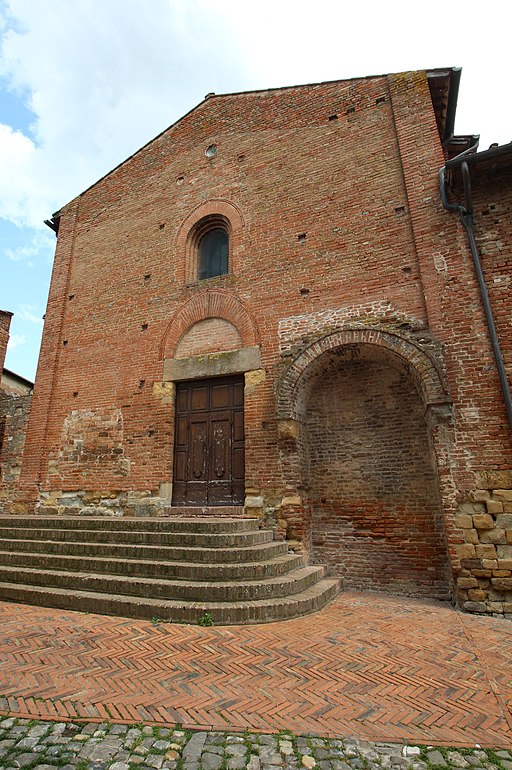 La chiesa dei Santi Tommaso e Prospero La chiesa dei Santi Tommaso e Prospero
 La chiesa dei Santi Tommaso e Prospero, interiore La chiesa dei Santi Tommaso e Prospero, interiore
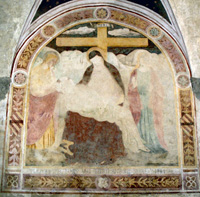
Pier Francesco Fiorentino, Pietà, Certaldo, Palazzo Pretorio
 Pier Francesco Fiorentino, Incredulità San Tommaso Pier Francesco Fiorentino, Incredulità San Tommaso
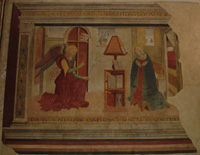
Scuola del Ghirlandaio, Annunciazione, affresco, Certaldo, chiesa SS. Tommaso e Prospero, XV secolo
|
Bibliography
F. Allegri – M. Tosi, Certaldo poesia del Medioevo, collana “Valdelsa Millenaria”, Certaldo (Fi), Federighi Editori, 2002, pp. 109 - 111.
A. Padoa Rizzo, Benozzo Gozzoli in Toscana, Firenze, Octavo, 1997, pp. 90 - 97.
Emanuele Repetti, Dizionario geografico, fisico, storico del Granducato di Toscana, Firenze, 1833-1846.
Luigi Santoni, Raccolta di notizie storiche riguardanti le chiese dell' Arci Diogesi di Firenze, Firenze, Tipografia Arcivescovile, 1847.
Attilio Zuccagni-Orlandini, Indicatore topografico della Toscana Granducale, Firenze, Tipografia Polverini, 1857.
Luigi del Moro, Atti per la conservazione dei monumenti della Toscana compiuti dal 1 luglio 1893 al 30 giugno 1894. Relazione a S.E. il Ministro della Pubblica Istruzione, Firenze, Tipografia Minori corrigendi, 1895.
Guido Carocci, Opere d'arte e ricordi storici di Castelfiorentino e Certaldo, Miscellanea Storica della Valdelsa, 1895.
Michele Cioni, Elenco di varie costruzioni monumentali in Valdelsa e notizie di pubblicazioni, Miscellanea Storica della Valdelsa, 1903.
Michele Cioni, La Valdelsa: guida storico-artistica, Firenze, Lumachi, 1911.
Mario Salmi, Architettura romanica in Toscana, Milano-Roma, Bestetti&Tumminelli, 1927.
Italo Moretti; Renato Stopani, Chiese gotiche del contado fiorentino, Firenze, UPI, 1969.
Italo Moretti; Renato Stopani, Architettura romanica religiosa nel contado fiorentino, Firenze, Salimbeni, 1974.
Francesca Allegri; Massimo Tosi, Certaldo. Guida storico-artistica., Certaldo, Tipografia Nidiaci, 1978.
AA. VV., Toscana paese per paese, Firenze, Bonechi, 1980.
Renato Stopani, Storia e cultura della strada in Valdelsa nel medioevo, Poggibonsi, Centro Studi Romei, 1986.
Renato Stopani, La Via Francigena. Una strada europea nell'Italia del medioevo, Firenze, Le Lettere, 1988.
Vittorio Cirri; Giulio Villani, La Chiesa Fiorentina. Storia Arte Vita pastorale, Firenze, LEF, 1993.
AA. VV., Chiese medievali della Valdelsa. I territori della via Francigena tra Firenze, Lucca e Volterra, Empoli, Editori dell'Acero, 1995. ISBN 88-86975-18-X
Marco Frati, Chiesa romaniche della campagna fiorentina. Pievi, abbazie e chiese rurali tra l'Arno e il Chianti, Empoli, Editori dell'Acero, 1997. ISBN 88-86975-10-4
Rosanna Caterina Proto Pisani; Anna Benvenuti Papi, Empoli, il Valdarno inferiore e la Valdelsa fiorentina, Volume 14 di I luoghi della fede, Milano, Mondadori, 1999. ISBN 88-04-46788-6
AA. VV., Firenze, Milano, Touring Club Italiano, 2001. ISBN 88-365-1932-6
Francesca Allegri; Massimo Tosi, Certaldo poesia del Medioevo, Certaldo, Federighi Editore, 2002. ISBN 88-900705-4-4

Comune Certaldo | www.comune.certaldo.fi.it
BEGO - Museo Benozzo Gozzoli | Storie di sant'Agostino | www.museobenozzogozzoli.it
Museo Benozzo Gozzoli | La Regola di Agostino | La filosofia di Agostino | Agostino e il neoplatonismo nell’estetica rinascimentale
Biografia | Il ritorno a Firenze e la partenza per San Gimignano (1459 - 1467)
Arte in Toscana | Benozzo Gozzoli
Diane Cole Ahl, Gozzoli, Benozzo: Benozzo Gozzoli, New Haven: Yale University Press, 1996.
Art in Tuscany | Benozzo Gozzoli, Procession of the Magi in the Palazzo Medici-Riccardi in Florence | The Vintage and Drunkenness of Noah and other frescoes in Pisa | Fresco cycle in the apsidal chapel of Sant'Agostino, San Gimignano Sant'Agostino | Saint Sebastian
Giorgio Vasari | Lives of the Most Excellent Painters, Sculptors, and Architects | Benozzo Gozzoli
Giorgio Vasari | Le vite de' più eccellenti architetti, pittori, et scultori italiani, da Cimabue insino a' tempi nostri | Benozzo Gozzoli
|
Questo articolo è basato sulgli articoli Benozzo Gozzoli, Tabernacolo dei Giustiziati e Chiesa dei Santi Tommaso e Prospero dell' enciclopedia Wikipedia ed è rilasciato sotto i termini della GNU Free Documentation License.
Wikimedia Commons contiene file multimediali su Benozzo Gozzoli e Ex chiesa dei Santi Tommaso e Prospero.
|

Holiday accomodation in Tuscany | Podere Santa Pia | Artist and writer's residency
|
| |
|
|
|
|

. |
|
|
Podere Santa Pia |
|
Podere Santa Pia, garden view, April |
|
Colle di Val d'Elsa |
| |
|
|
|
|
|
|
|
|
 |
Pisam |
|
Montefalco |
|
San Gimignano |
| |
|
|
|
|
Certaldo
|
|
|
|
|
Inhabited since the Etruscan times, the name Certaldo derives from the Latin phrase “cerrus altus” or from the Germanic, “cerrus aldo,” meaning 'a rise covered in oaks.
In 1164, Emperor Frederick Barbarossa conceded an area of ruins to the Alberti Counts in Prato, thus allowing them to take possession of the area where Palazzo Pretorio now stands.
In 1184, Certaldo came under the control of Florence. The family of Giovanni Boccaccio (1313 – 1375) lived in Certaldo during various periods in what has become today a museum dedicated to the great writer and poet.
The ancient centre, also called “Castle” in Italian, is located inside the city's medieval defensive walls. Ancient doors gave access to the central core: Porta Alberti, Porta al Sole and Porta al Rivellino.
You can reach the ancient centre by taking the enchanting roads of Via Costa Alberti and Costa Vecchia, or the more modern Via del Castello. You can also reach the centre via a funicular railway, departing from piazza Boccaccio.
Highlights
The principal feature of most medieval hamlets, like Certaldo, is their main square. In medieval times, a town's major buildings and local powers faced onto its main square, where the religious, political, civil and commercial headquarters were based. Certaldo, instead, is located on the slopes of a hillside and it didn't have much space for a large piazza.
Thus, major buildings representing the local powers were located along via Boccaccio: the seat of the church; the building of civic power, Palazzo Pretorio; the Market Loggia, Palazzo Stiozzi Ridolfi (which is closed today but whose ancient walls can still be seen).
The squares that exist in Certaldo today were in the past gardens, set up to feed citizens in the event of siege.
Palazzo Pretorio
Palazzo Pretorio, the most representative monument in Certaldo, was the ancient residence of the Alberti Counts, which they built in the late-12th century atop the ruins of the family's former homes.
Today, the prisons are still visible as are the meeting rooms, the archive, the chapel and the private lodgings of the vicars. On its facade and inside its courtyard are numerous coats of arms, representing the families of each of the vicars that lived in and governed from there.
In the Palazzo, there are frescoes from the 15th and 16th centuries. Next to Palazzo Pertorio is the San Tommaso and Prospero church, which dates back to the 13th century.
Museum of sacred art
Was originally an Augustinian convent from the 15th century. Beautifully restored and turned into a museum, it was inaugurated in 2001.
The exhibition rooms showcase paintings, sculptures and sacred relics and items. The painting gallery, or pinacoteca, is in the old frescoed refectory of the convent, and today showcases ancient paintings that date back to the 12th century to the 16th century.
Here, you can admire works by such distinguished artists as Cenni di Francesco di Ser Cenni, Ugolino di Nerio and Meliore. Among the important works present is a wooden crucifix, from the San Pietro a Petrognano church, which dates back to the early 13th century. It has been attributed to an unknown Tuscan sculptor.
It is, indeed, unique in the world of medieval Italian sculpture: the image of Christ, triumphant over Death, has gained much recognition in art criticism thanks to the sculpture's expressive force.
|
|
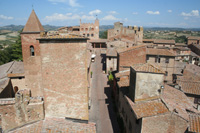
Certaldo
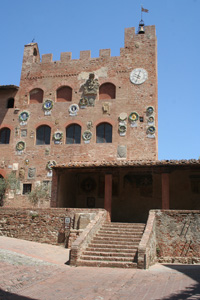
Certaldo, Palazzo Pretorio
|
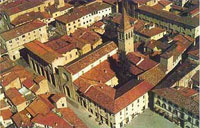
|
|
|
|
|
Sansepolcro |
|
Siena, Duomo |
|
Firenze, Duomo |
| |
|
|
|
|
![]()
![]()
![]()
![]()

